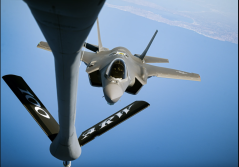Air Force, Navy should work more closely to develop 6th-gen fighter, senator says

SIMI VALLEY, Calif. — A key lawmaker on the Senate Armed Services Committee is suggesting that the Air Force and Navy work hand-in-hand to develop their respective sixth-generation fighter jets, rather than take diverging paths.
The two services have discussed how to keep their sixth-generation aircraft — the Next Generation Air Dominance (NGAD) platform and F/A-XX, respectively — complementary, but they’re running two separate programs that feature different airframes and propulsion systems.
As they continue development work on the different aircraft, Sen. Mark Kelly, D-Ariz., said the Air Force and the Navy should consider areas of joint collaboration — similar to the Pentagon’s acquisition strategy for the F-35 Lightning II.
“I would ultimately like to see — and I’ve stressed this to the Air Force and the Navy — that when we consider what we’re going to build next is [to] do what we did with the F-35, with a caveat to that,” Kelly said Saturday during a meeting with reporters during the Reagan National Defense Forum. “I think it helps if we can jointly build whatever the next system is. I think that would be a positive thing.”
He didn’t elaborate on the “caveat” that he was contemplating.
The F-35 fifth-gen fighter jet was born from the Joint Strike Fighter program, an effort to develop a single family of aircraft to replace a range of legacy platforms for the Air Force, Navy and Marine Corps — as well as for select international partners. The plane has multiple variants but all share the same basic design, avionics system, stealth technology and single-engine configuration.
The comments from Kelly come after the Air Force on Thursday announced it would defer a decision on the NGAD platform to the upcoming Trump administration. The service originally planned to award a contract for the aircraft by the end of 2024, but decided to pause the program’s selection process earlier this year due to risks posed by budget uncertainty and advancements in new technologies.
Meanwhile, the Navy is marching forward on its own sixth-gen fighter — currently known as the F/A-XX. Chief of Naval Operations Adm. Lisa Franchetti told reporters in October that the sea service was in the process of source selection and is still committed to fielding the aircraft in the 2030s.
In a recent interview with Aviation Week, Rear Adm. Michael Donnelly, director of the Office of the Chief of Naval Operations’ air warfare division, emphasized that the F/A-XX is independent of the Air Force’s NGAD. Notably, the sea service’s aircraft will feature a different airframe and leverage a derivative-type engine — as opposed to the Air Force’s adaptive-cycle jet engine technology being developed through the Next Generation Adaptive Propulsion (NGAP) program.
When asked about the differences, Kelly said that the two services “should sit down and talk about it.”
As for NGAD, Kelly acknowledged that the Air Force made the right decision to pause the program and decide the best way to move forward, especially considering how quickly adversaries are developing new capabilities that can better detect and destroy U.S. military systems.
“These high-value assets are going to be held at risk. And how are we going to best deal with it? Maybe it is a sixth-gen fighter,” he said. “I think some of this technology has advanced very quickly, so I do agree with the secretary of the Air Force that it is appropriate to kind of take a pause here and figure out what direction we should go.”






